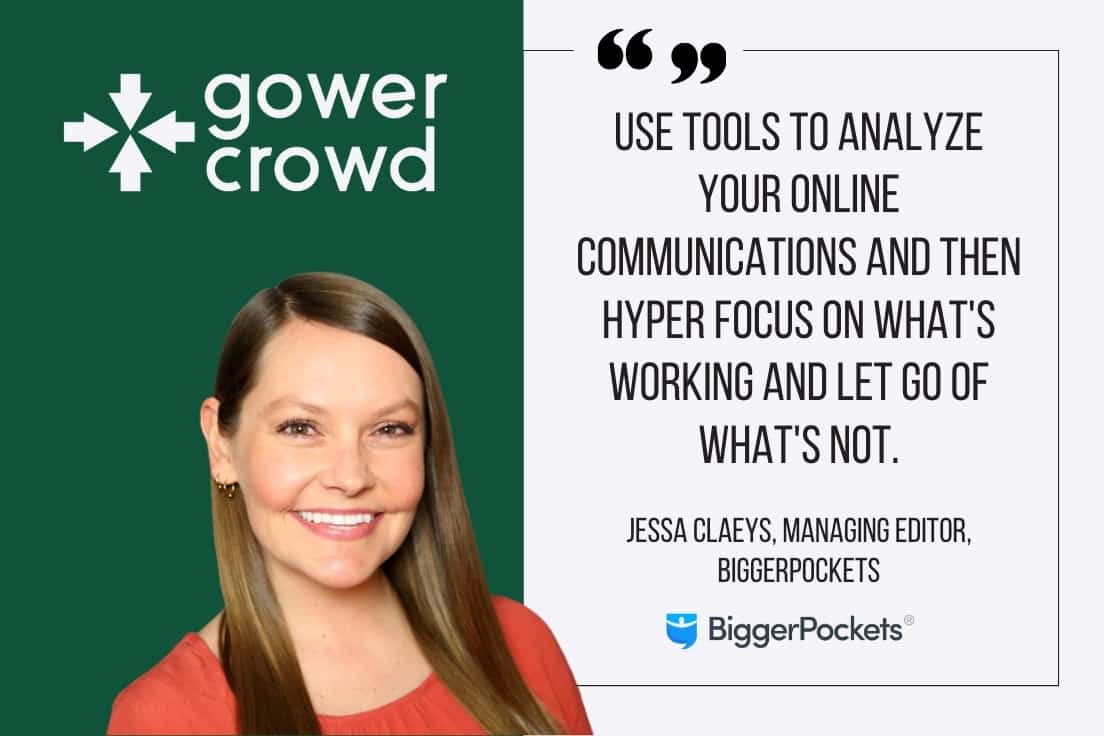How to Write Real Estate Content that Gets Read
This article was written based on a conversation I had with Jessa Claeys, managing editor at BiggerPockets.

There’s been a notable shift in recent years from outbound marketing to inbound marketing. Rather than cold calling, sending mailers or otherwise directly advertising to prospects, real estate professionals are leveraging inbound marketing strategies – strategies that bring people to them.
At the heart of every inbound marketing campaign is what’s known as “content marketing.”
Content marketing is the creation and sharing of online materials – such as blog posts, white papers, podcasts and videos – that does not explicitly promote a product or service. Instead, the materials provide information relevant to a target audience in a way that stimulates interest in that product or service. The end goal is to use content marketing to generate new leads and close more deals.
There are many forms of real estate content market, which is a subject for another day. Today, we want to drill down on how to create real estate content that gets read.
Get access to our FREE weekly newsletter exclusively covering the latest updates from the real estate crowdfunding world
Using Real Estate Content to Boost Your Sales Efforts
Real estate content marketing can be a powerful tool for real estate owners, investors, developers and the like. Any real estate professional looking to boost their sales can utilize real estate content – in one form or another – to reach new audiences.
To get started, you’ll want to lay out your goals for creating real estate content. For example, if you’re a developer interested in using crowdfunding to raise capital for a deal, your goals are going to look very different than someone who is an investor looking to find property to buy. Your end goals will influence the type of content you write, and for whom.
When used effectively, real estate content marketing can help you position yourself as an expert in the field. Thankfully, in today’s world, it’s not too difficult to become an expert: if Google says you’re an expert, you’re an expert!
But on a serious note, in order to be recognized as an expert, you must provide high-value content to your audience on an ongoing basis.
Prove to people that you know what you’re talking about. As you publish a repository of content, people will start to view you as a trusted resource. They’ll start coming to you when they have questions or new ideas. The more trust you can build with your audience, the more likely you are to develop relationships that ultimately translate into sales.
Real Estate Content Writing: A Lost Art
To be fair, creating high-value real estate content is actually harder than you might think. In fact, real estate content writing – like all writing – is bit of a lost art. There are a few reasons why this is the case. First, in our experience, the best writers tend to be people who are passionate readers. The more people read, the more they absorb proper sentence structure, grammar, etc.
We’re talking about people who read books (like, actual novels! – imagine that?!). Scanning a sports blog doesn’t have the same effect in terms of making someone a strong writer. It almost seems that people have become so busy, in today’s day and age, that fewer and fewer people have the time to read.
Second, how we write has changed over time. It’s an interesting paradox. On the one hand, people are picking up the phone less and relying on emails/texts to communicate. So technically, people might be writing more than people did in generations past. But on the other hand, people nowadays tend to write in short-form. They shoot off short, incomplete sentences via email or use abbreviations and emojis to communicate via text. “Got it- thx” is a common response. As is a “thumbs up” emoji. This is much different than long-form writing, which real estate content market so often relies upon.
What this means, as a result, is that few people are truly great writers these days. In order to be effective with your real estate content marketing, you must be able to present information in a way that is clear, concise, informative and compelling. That can be tricky, but it’s not impossible.
How to Start Writing Real Estate Content
I hope we didn’t take the wind out of your sails. Even if you aren’t a great writer today, you can certainly become a great writer with some practice. Here are a few tips for those looking to get started.
Identify Your Audience
First, identify your target audience(s). Who are you writing real estate content for? Are you targeting entry-level investors? Developers? Brokers? Property owners? How much real estate experience does your audience have? If you are targeting people who are more sophisticated, your real estate content will need to be more nuanced than if you were speaking to someone who’s just investing for the first time.
Knowing your audience is important because you want to “meet them where they’re at” – for lack of a better phrase. You want to use language they’ll understand and be able to relate to. If you’re targeting small-time, entry-level investors but your content is loaded with technical information, acronyms and real estate jargon, you’ll quickly lose people’s attention. The better you know your audience, the more relatable and effective your real estate content will be.
Knowing what to write about
Let’s say you know your target audience. The next step is understanding what types of content they want to read. What are their pain points? What questions do they have? You’ll want to speak to that.
This is where the internet can be a powerful tool. The internet has leveled the playing field of knowledge. A simple Google search can reveal the most commonly asked questions by your audience. You’ll want to answer those types of questions in your content. If you don’t have the answers, don’t worry—you can rely on Google once again to do the research you need on the topic. Truthfully, you can become an expert on just about any topic these days by doing a deep dive on Google.
Schedule Uninterrupted Time to Begin Writing Real Estate Content
Let’s assume that at this point, you know your objective(s) for writing content, you know your target audience(s), and you know what types of real estate content you want to produce. Now it’s time to get writing!
Writing (of any kind) takes time and concentration. In today’s world, busy real estate professionals are getting pinged every few minutes with emails, texts, and phone calls. Pre-COVID, you might have been working in an office where coworkers stopped by unannounced. You might have been sitting in a cubicle or other open office environment where distractions were constant. In the COVID-era, distractions still occur, they might just be coming from a different place. For example, instead of coworkers dropping by your desk, you might have children at home, tugging at your pantlegs or asking for help with homework.
Whatever the case may be, if you want to write effective real estate content, you need to block out a few hours where you can silence your devices and focus on the piece at hand.
Related Article: Learn More About the Real Estate Development Process
How to Write Real Estate Content that Appeals to Everyone
There are two schools of thought: one that believes real estate content should be highly specific and targeted, and another that believes real estate content should be written in a way that appeals to everyone. These schools of thought aren’t mutually exclusive.
You may be writing to a specific audience, but the content you write should be written to appeal to everyone in that audience.
What does this mean in practice? It means you need to be careful with jargon. Don’t assume that people know what a “1031-exchange” is or that someone understands what you mean when you reference the LIBOR index, HELOCs, GSEs, PSAs and the like. Use acronyms sparingly. And always define key terms or principles that someone might be hearing for the first time.
As a rule of thumb, we recommend writing to a third-grade level. Now, we know that real estate professionals are often highly educated. But nevertheless, you want your writing to have broad appeal within your audience. Writing to a third-grade level will force you to write clearly, concisely, and in a manner than is easy for people to digest.
The Difference Between Sales Writing vs. Educational Writing
Real estate content marketing can be used in many ways. Some people lean towards sales writing. Others prefer educational writing. It is important to understand the distinction.
Real estate sales writing tends to be more focused on a specific deal, product, or investment opportunity and is written with the intention of calling the reader to some immediate action – like “invest now.” The ask is more blatantly in someone’s face. Sales pitches can be an effective way to demonstrate that you’re a leader in your field, but as they are oriented to the sale, they are structured to carry the reader along a journey of anticipation that builds to a pitch and a close.
Written well, a good sales letter can substantially move a prospect along in their journey to investing with you – but they are more effective if you have already built a relationship with the prospect through your educational articles.
Educational writing, therefore, is intended to serve as a resource for a broader swath of your audience. It is information that they can use whether they engage in a deal with you or not and serves primarily to build a relationship with the prospect. This increases the chance of a successful close when you do pitch a deal by pre-empting questions your prospects may have and by providing value in advance that predisposes them to investing with you – before you even ask. For example, you might write a white paper on the nuances of real estate waterfalls and how they are used in the industry.
There’s a balance to be had between sales writing and educational writing. Real estate content marketing IS that balance. Content marketing is designed to provide readers with valuable information, while subtly integrating your own message into the piece. It delicately weaves your value proposition into the larger piece. Magazines have been doing this for decades; real estate professionals are now iterating on that concept by using content marketing geared toward their own industry.
For example, if your firm specializes in conducting cost segregations studies, you might author a detailed piece on how a cost segregation study can save a hotel investor tens of thousands of dollars this year by frontloading their depreciation. You might integrate a few case studies based on your work with existing clients to highlight how this saved each of them money. If presented in a compelling way, the educational piece may be the catalyst a hotel investor needs to call the author of the piece to ask whether their company can conduct a cost segregation study for his hotel, too.
Consider What Your Audience Wants to Know
We’ve touched upon this briefly already but let us elaborate. To be effective, you must write real estate content that speaks to your audience’s specific interests. For example, if you’re looking to develop new relationships with apartment investors in the Midwest, you might publish a series of mini white papers that look at the Q3 multifamily market trends in hyper-focused geographies.
This provides your audience with highly relevant information that they want to know and positions you as a leader in the field who is actively monitoring the changing market landscape.
This same audience may not care about something like how COVID is impacting office rents, so steer clear of topics that will not resonate with your target audience.
Provide Readers with Specific, Actionable Steps
Some of the most effective real estate content are educational pieces that provide readers with specific, actionable steps.
Let’s go back to the example above, of the company that does cost segregation studies. In addition to explaining how cost segregation studies can save hotel investors money, the company would also want to provide clear “next steps” for the readers who are looking to pursue this cost-saving strategy. For example, how do they get started with a cost segregation study? What information will they need to gather? How much will this study cost? How long does it take to complete? When does it need to be completed in order to realize the tax savings this coming year?
This is all pertinent information that will allow hotel investors to get the ball rolling. The final call to action, in this case, might be something along the lines of “Ready to do your own cost segregation study? Give us a call today.”
Know Your Tone When Writing Real Estate Content
There are generally two ways of conveying real estate content. The first is with storytelling. Storytelling draws on the author’s own experiences related to a specific topic. For example, a person might write an article about how they got started as a real estate investor. Maybe the story talks about buying a duplex that they owner-occupied to get the best interest rate and cost savings.
The story might weave in details about the buying process, hiccups that arose, and how they overcame those challenges. Real estate content that uses story telling will often provide lessons learned, which is the insight their audience typically cares about the most.
The other form of real estate content is written in the third person. These articles tend to be more informational and straight to the point. Someone writing these pieces will want to keep their own experiences out of the narrative, saving their own personal stories for a different piece entirely.
Both forms of real estate content can be highly effective. In any event, it is important for the author to consider their tone when writing the piece—know which style of article you’re going for before you begin writing.
How to write emails that get read
If you’re like 90% of people, you’re probably reading this article on your smart phone or tablet. The overwhelming majority of real estate content consumed this way. This impacts how your content needs to be laid out and designed. An article that looks beautiful on your desktop might display poorly on someone’s mobile device.
This also impacts how your emails are written. Your subject lines should be punch (more on this below), with the hard-hitting words at the very beginning. And then, whatever message you’re looking to convey, that needs to be clearly stated in the first few words of your email. People tend to scan their email inboxes, so if you don’t capture their attention right away, your email could get deleted before it ever gets read – making all of your efforts for naught!
While most of this article focuses on written real estate content (e.g., writing for blogs, emails, newsletters, etc.), there are other forms of real estate content, such as videos and podcasts. No matter what format you’re using to present your real estate content, be sure it’s optimized accordingly.
How to write great email subject lines
Perhaps more important than the body of your email is the subject line you present it with. If your subject line falls flat, people will ignore or delete your email without ever opening it to find what tremendous value lies inside.
So, how do you create subject lines that people will read?
Start by putting the hard-hitting terms at the beginning of the subject line. Whatever value you’re delivering, say so in a few short words to get your readers’ attention.
How do you know what will get your readers’ attention? A little trial and error goes a long way.
Content marketing pros often use what’s known as “A/B testing” to determine the efficacy of their subject lines. The concept is actually quite simple. Create two subject lines for the same email you’re planning to send out. Take a small subset of your email listserv (say, 10%) and send half of those subscribers the email using the “A” subject line, and the other half the email using the “B” subject line. Wait an hour or two and look at the metrics for how each email performed. Which subject line resulted in more emails being read? Which led to more clicks? This is the subject line you’ll want to use when you send the email out to the rest of your listserv.
This might seem like a lot of work, but thankfully, Convertkit, Mailchimp, and other automated email platforms can be used to automate this process. Look at the tools that are available to you via your existing email provider, and then use these tools to your advantage.
For subject lines, start with sites like Digg.com to see what headlines are trending now and adapt them for your own topic, and then use tools like Subject Line Tester to refine your subject lines until they are just right.
3 Final Tips for Creating Real Estate Content that Gets Read
I recently had the pleasure of talking with Jessa Claeys, the Managing Editor for BiggerPockets.com – one of the largest and most trusted sources of user-generated real estate content. Jessa has more than a decade of experience as a copywriter and editor for both print and digital publications. When I asked her for some finer-grained advice for people looking to create real estate content that gets read, she gave me the three following tips:
- Personalize your emails. Jessa made the astute observation that people tend to be at least somewhat self-absorbed, and that writers should work that to their advantage! She suggests personalizing emails by addressing readers by name and using language like “your” to speak to people, as opposed to more generic language like “investors”. Make people feel like you’re speaking directly to them and not hundreds or thousands of others just like them.
- Make your content time sensitive. People like to feel like they’re staying up to speed on the latest news and trends. As such, she recommends writing content that weaves in language like “in 2020” or use year-over-year statistics to show that information is still relevant. This trick can be used even when providing evergreen content (i.e. content that remains relevant regardless of point in time). For example, someone writing a piece on solar might frame the article around “How Solar is Saving Investors Money in 2020”.
Solar might have been saving investors money in 2019, 2018 and 2017 – and might continue to save investors money in 2021 – but the article feels fresh by appearing more time-sensitive. There are other ways to make your content feel fresh. For example, you might take an evergreen piece and weave in some additional narrative around COVID-19 (as appropriate) to make the article seem new again. Or you might draw on a recent, recognizable news headline to make the article feel as though it’s just been written for the first time.
- Have a thick skin. This is a great piece of advice that we couldn’t agree with more. As you build your repertoire of real estate content, you’ll eventually find that not everyone agrees with what you’ve said. People interpret content through their own lens, based on their own personal experiences. You can’t control for that. If someone objects to your message or your advice, let it go. For every person who disagrees with you, three others may be nodding their heads in alignment with every word you’ve said.

CONCLUSION
Writing real estate content that gets read can be challenging, but once you get the hang of it, it can be really satisfying. For people who are otherwise crunching numbers and analyzing deals all day, real estate content can be a great creative outlet for sharing their knowledge and experience.
At the same time, writing isn’t for everyone. Those who are looking to leverage real estate content marketing, but who don’t enjoy writing, may want to consider enlisting the support of a third party. A little known fact is that many real estate professionals – even those who have used content to establish themselves as “experts” in the field – actually have someone else write the content for them. They’ll provide direction and advice, but they don’t write the material themselves. This strategy is totally OK – especially if it’s the only way you get around to producing real estate content that gets read.
If you liked this article and would like to learn more about real estate financing, check out some of the resources below:
If you have only just started in real estate development, have completed no deals, have no email list, but know you want the freedom and wealth being a real estate developer brings, then I suggest your first step is to start evaluating deals so you can recognize a good one when you see it.
Here’s where you should start. You’ll learn everything you need to know – the different types of real estate, different development strategies, how real estate cycles influence the market, and all about due diligence.
If you want to find deals and raise money for them so you can start your real estate development business, then learning how to conduct due diligence so you can pitch your deals better to investors is a great place to start.
If you’ve already purchased one or more real estate project and are seeing more opportunities than you can finance, then now is the time to start building your investor network so you can finance all your next deals quicker.
You’ve already got some momentum; now start finding and educating prospects about what you’re doing so you can build an email list of people to pitch to when you’re ready to raise money for your next deal.
This is what we build for private clients all the time – it’s called the Investor Acquisition System and you can access the entire program right here so you can find prospects, and convert them into being deep pocketed, repeat investors in your deals.
If you are a seasoned pro with multi-cycle experience, a substantial portfolio, a decent deal pipeline, and find yourself spending too much time raising equity capital because you’re still doing it in-person, then it’s time you put technology to work for you.
The wonderful thing about doing this is that you’re not going to be doing anything different than you’re already doing and, guess what, you’ll never have to sit through investor meetings again.
Sounds crazy I know, but I lay the whole thing out for you in this white board workshop where I personally show you exactly what it takes for you to transform your equity raising into a fully automated, capital raising machine so you can find new investors while increasing commitments from your existing network.






